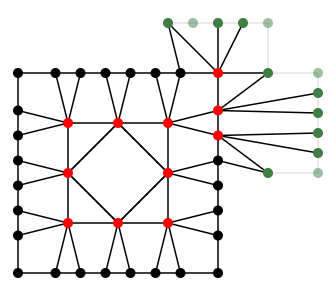Consider a neighbourhood complex of eight vertices (red) with vertex configuration $(3.4)^3$ which gives rise to the tritetragonal tiling of the hyperbolic plane:
Not knowing if this complex can be uniformly closed – by adding edges such that all vertices in the resulting graph have vertex configuration $(3.4)^3$ – one might start trying to do so. Start "complementing" the first three vertices (from the top right one down). First create the missing faces virtually:
You end up with a sequence of connected virtual vertices which now have to be identified with a free sequence on the border of the complex. ("Free" means that each vertex in the sequence on the border must have degree $d \leq 6-k$ where $k$ is the number of new edges attached to the virtual vertex (black) – except for the dummy vertices (pale green).)
You can continue this process – complementing one vertex with $d < 6$ after the other and identifying the sequence of new virtual vertices with a free sequence – but most probably you will get stuck and not find a free sequence before you are done.
What does this mean?
Will this procedure never be successful for this specific neighbourhood complex?
If it can be successful: How do I have to choose a correct free sequence in each step? (There may be several.)
If it can not be successful: Are there other neighbourhood complexes for which it is?
Edit: This is a slightly larger neighbourhood complex containing $36$ vertices with configuration $(3.4)^3$ (exactly the ones in the original complex above).



